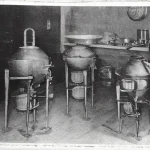In the pulsating heart of every internal combustion vehicle lies an engineering marvel: the engine. Far more than just a collection of metal parts‚ it’s a symphony of precision‚ power‚ and decades of relentless innovation. Yet‚ behind the roar and the impressive torque figures‚ an intricate and often opaque financial narrative unfolds – the car engine manufacturing cost. This isn’t merely a line item on a balance sheet; it’s a dynamic‚ ever-evolving economic landscape that profoundly shapes the automotive industry’s future‚ dictating everything from vehicle pricing to the pace of technological adoption.
For decades‚ optimizing these manufacturing costs has been a relentless pursuit for automakers worldwide‚ a delicate dance between cutting-edge technology and economic realities. From the initial design blueprints‚ meticulously crafted by brilliant engineers‚ to the final‚ rigorous testing phases‚ every single step in the production chain carries a significant financial implication. Understanding these underlying expenses – encompassing everything from raw material procurement to sophisticated robotics and highly skilled labor – offers a fascinating glimpse into the colossal investments driving automotive progress. By integrating insights from advanced analytics and lean manufacturing principles‚ companies are continuously striving to achieve a remarkable balance: delivering unparalleled performance while strategically optimizing every dollar spent.
Before we delve deeper into the future-forward strategies reshaping this crucial economic pillar‚ let’s establish a foundational understanding of the key elements that contribute to an engine’s birth.
| Cost Factor Category | Description | Impact on Total Cost |
|---|---|---|
| Raw Materials | Metals (aluminum‚ steel‚ iron‚ rare earth elements)‚ specialized alloys‚ plastics‚ rubber‚ lubricants‚ and advanced ceramics. | A significant portion of the cost‚ heavily influenced by global commodity markets‚ geopolitical stability‚ and ethical sourcing requirements. |
| Manufacturing Processes | Precision casting‚ advanced machining (CNC)‚ forging‚ heat treatments‚ intricate assembly‚ welding‚ and surface finishing techniques. | High capital expenditure due to energy consumption‚ requirement for highly specialized‚ often custom-built machinery‚ and maintaining exceptionally tight tolerances. |
| Labor & Overhead | Wages for highly skilled engineers‚ specialized technicians‚ assembly line workers‚ quality control experts‚ factory utilities‚ maintenance‚ and facility management. | Substantial and variable‚ reflecting regional labor costs‚ the level of automation employed‚ and the complexity of the manufacturing operation. |
| Research & Development (R&D) | Conceptual design‚ simulation‚ prototyping‚ extensive testing (durability‚ emissions‚ performance)‚ material science research‚ and compliance with ever-tightening global regulations. | A critical long-term investment for innovation‚ competitive differentiation‚ and meeting future environmental standards‚ typically amortized across multiple engine generations. |
| Tooling & Capital Expenditure | Development and acquisition of specialized molds‚ dies‚ jigs‚ fixtures‚ advanced robotic systems‚ automated inspection equipment‚ and the entire production line setup and infrastructure. | Represents a massive initial investment‚ which is subsequently depreciated over the expected lifespan and production volume of a specific engine model. |
| Logistics & Supply Chain Management | Transportation of raw materials and finished components‚ inventory management‚ warehousing‚ international tariffs‚ customs duties‚ and managing complex global supplier networks. | Adds considerable complexity and cost‚ particularly in a globally integrated industry‚ requiring sophisticated planning and risk mitigation strategies. |
| Quality Assurance & Testing | Implementing rigorous testing protocols at every stage‚ non-destructive testing‚ dyno testing‚ real-world simulations‚ and dedicated quality control personnel. | Absolutely essential for ensuring product reliability‚ safety‚ and brand reputation‚ effectively preventing costly recalls and warranty claims down the line. |
Reference: Data compiled from various industry reports and automotive manufacturing analyses. For further insights into global automotive manufacturing trends‚ visit resources like OICA (International Organization of Motor Vehicle Manufacturers).
The Material Maze: Navigating Global Supply Chains
At the foundation of every engine’s creation are its raw materials. Aluminum‚ steel‚ iron‚ and an increasing array of specialized alloys form the very backbone‚ each chosen for its specific properties of strength‚ heat resistance‚ and weight. The global pricing of these commodities‚ often subject to geopolitical shifts‚ trade policies‚ and demand-supply imbalances‚ can dramatically sway manufacturing budgets. Consider the ongoing volatility in steel prices or the surging demand for rare earth elements critical for catalytic converters and advanced sensors; these external factors exert immense pressure on automakers. By strategically diversifying suppliers and investing in material science research‚ manufacturers are proactively seeking lighter‚ stronger‚ and more cost-effective alternatives‚ ultimately driving down the inherent material cost while enhancing performance.
The Robotics Revolution: Precision and Efficiency
The modern engine factory is a testament to technological prowess‚ a meticulously orchestrated ballet of advanced robotics and human expertise. Automated assembly lines‚ once a futuristic vision‚ are now standard‚ performing tasks with unparalleled precision and speed. Robotic arms‚ precisely welding and joining components‚ significantly reduce labor costs for repetitive tasks while dramatically enhancing consistency and quality. This isn’t about replacing human workers entirely but rather about augmenting their capabilities‚ allowing skilled technicians to focus on complex problem-solving‚ quality control‚ and the programming of these sophisticated machines. Investing in such capital-intensive automation‚ while costly upfront‚ yields substantial long-term benefits in efficiency‚ waste reduction‚ and production scalability‚ profoundly reshaping the landscape of car engine manufacturing cost.
The Electrification Epoch: A Paradigm Shift
Perhaps the most significant force currently influencing the car engine manufacturing cost is the accelerating global shift towards electric vehicles (EVs). As major automotive players commit to phasing out internal combustion engine (ICE) production‚ investments are strategically redirecting towards battery and electric motor development. This transition creates a dual challenge and opportunity: manufacturers must simultaneously optimize existing ICE production for ongoing demand while rapidly developing new‚ cost-effective EV powertrain solutions. The expertise cultivated over a century in precision engine manufacturing is proving incredibly valuable in the production of electric motors‚ which‚ while mechanically simpler‚ still demand exceptional engineering and manufacturing exactitude. This period represents an exciting‚ transformative era for the industry‚ pushing the boundaries of what’s possible in powertrain design and cost optimization.
The Road Ahead: Innovation‚ Sustainability‚ and Value
Looking forward‚ the trajectory for car engine manufacturing cost is one of continuous innovation‚ driven by an unwavering commitment to efficiency and sustainability. Manufacturers are increasingly adopting circular economy principles‚ exploring advanced recycling techniques for materials and components‚ which promises to mitigate future raw material cost volatility. Furthermore‚ the integration of artificial intelligence (AI) and machine learning into design and production processes is unlocking unprecedented levels of optimization. AI-driven simulations can predict material stress points‚ refine machining parameters‚ and even identify potential bottlenecks in the supply chain long before physical production begins‚ dramatically reducing prototyping costs and speeding up time-to-market.
The future of engine manufacturing‚ whether for traditional powertrains or the burgeoning electric variants‚ is not merely about minimizing costs; it’s about maximizing value. It’s about crafting engines that are not only powerful and reliable but also environmentally conscious and economically accessible. By embracing cutting-edge technology‚ fostering collaborative innovation‚ and maintaining a forward-looking perspective‚ the automotive industry is confidently navigating this complex financial terrain‚ driving us towards a future of mobility that is smarter‚ greener‚ and more efficient for everyone.






